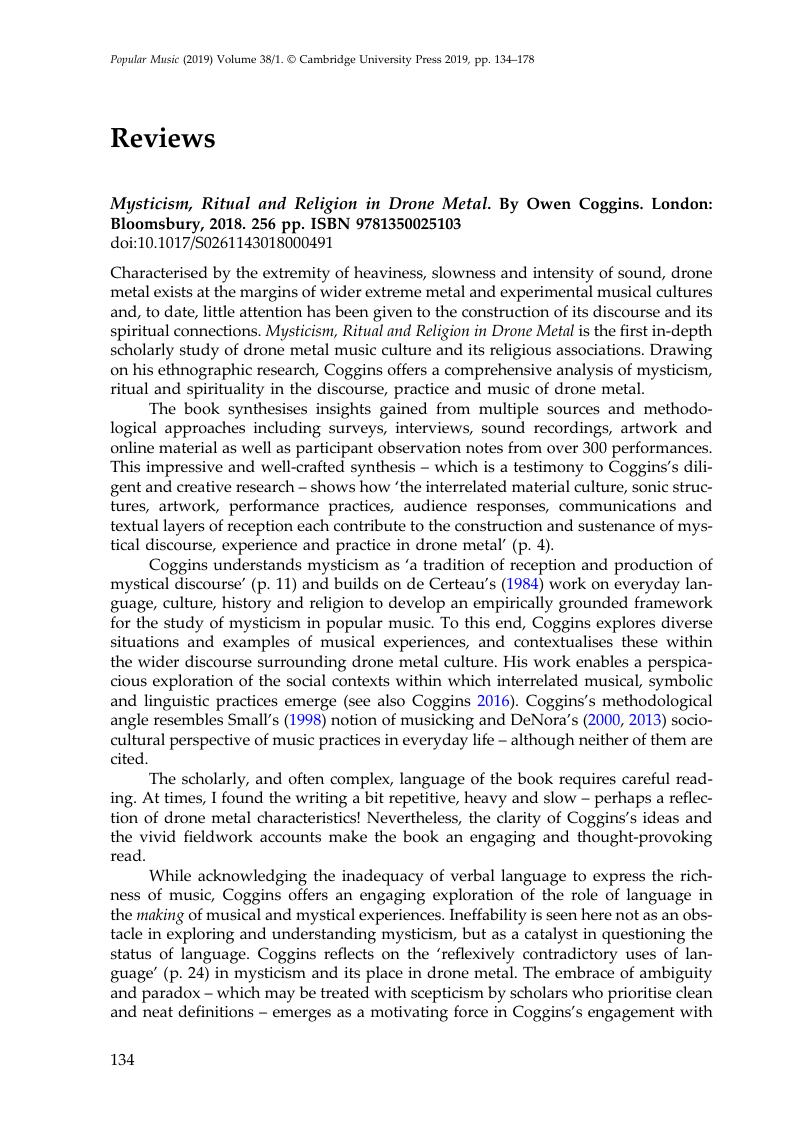No CrossRef data available.
Article contents
Mysticism, Ritual and Religion in Drone Metal. By Owen Coggins. London: Bloomsbury, 2018. 256 pp. ISBN 9781350025103
Review products
Mysticism, Ritual and Religion in Drone Metal. By Owen Coggins. London: Bloomsbury, 2018. 256 pp. ISBN 9781350025103
Published online by Cambridge University Press: 03 January 2019
Abstract
An abstract is not available for this content so a preview has been provided. Please use the Get access link above for information on how to access this content.

- Type
- Reviews
- Information
- Copyright
- Copyright © Cambridge University Press 2019
References
Bushong, D.J. 2002. ‘Good music/bad music: Extant literature on popular music media and antisocial behaviour’, Music Therapy Perspectives, 20, 69–79Google Scholar
Cobussen, M. 2008. Thresholds: Rethinking Spirituality Through Music (Farnham, Ashgate)Google Scholar
Coggins, O. 2015. ‘Experience, practice, writing: a methodological outline of drone metal research’, in Modern Heavy Metal: Markets, Practices and Cultures (International Academic Research Conference, 8–12 June 2015), ed. Karjalainen, T.M. and Kärki, K. (Helsinki, Aalto University), pp. 354–65Google Scholar
Coggins, O. 2016. ‘Transforming detail into myth: indescribable experience and mystical discourse in drone metal’, in Global Metal Music and Culture: Current Directions in Metal Studies, ed. Brown, A.R., Sprachlen, K., Kahn-Harris, K. and Scott, N. (New York, Routledge), pp. 311–29Google Scholar
De Certeau, M. 1984. The Practice of Everyday Life (Los Angeles, CA, University of California Press)Google Scholar
DeNora, T. 2013. Music Asylums: Wellbeing through Music in Everyday Life (Farnham, Ashgate)Google Scholar
Favazza, C. 2011. Bodies under Siege: Self-mutilation, Nonsuicidal Self-injury, and Body Modification in Culture and Psychiatry, 3rd edn (Baltimore, MD, Johns Hopkins University Press)Google Scholar
Glucklich, A. 2001. Sacred Pain: Hurting the Body for the Sake of the Soul (Oxford, Oxford University Press)Google Scholar
Herbert, R. 2016. Everyday Music Listening: Absorption, Dissociation and Trancing (London, Routledge)Google Scholar
Hines, M., and McFerran, K.S. 2014. ‘Metal made me who I am: seven adult men reflect on their engagement with metal music during adolescence’, International Journal of Community Music, 7(2), 205–22Google Scholar
Lacourse, E., Claes, M., and Villeneuve, M. 2001. ‘Heavy metal music and adolescent suicidal risk’, Journal of Youth and Adolescence, 30, 321–32Google Scholar
McFerran, K.S., and Wölfl, A. 2015. ‘Music, violence and music therapy with young people in schools: a position paper’, Voices: A World Forum for Music Therapy, 15(2). https://normt.uib.no/index.php/voices/article/view/831Google Scholar
Saarikallio, S., Gold, C., and McFerran, K. 2015. ‘Development and validation of the Healthy–Unhealthy Music Scale. Child and Adolescent Mental Health, 20(4), 210–17Google Scholar
Small, C. 1998. Musicking: The Meanings of Performing and Listening (Middletown, CT, Wesleyan University Press)Google Scholar
Stack, S. 1998. ‘Heavy metal, religiosity, and suicidal acceptability’, Suicide and Life Threatening Behavior, 28(4), 388–94Google Scholar
Tsiris, G. 2018. Performing spirituality in music therapy: towards action, context and the everyday. Doctoral thesis, Goldsmiths, University of London.Google Scholar
Tsiris, G., and Ansdell, G. (forthcoming). Special issue on ‘Exploring the spiritual in music: Interdisciplinary dialogues in music, wellbeing and education’. Approaches: An Interdisciplinary Journal of Music Therapy, 11(1).Google Scholar


